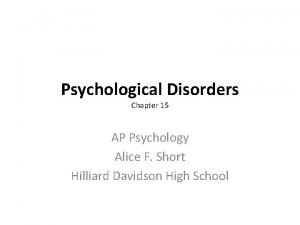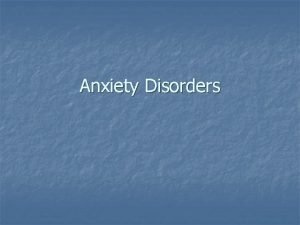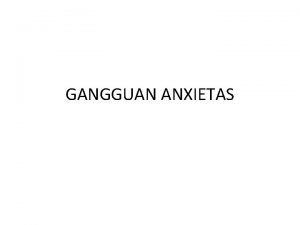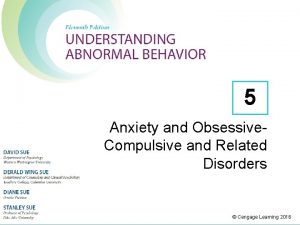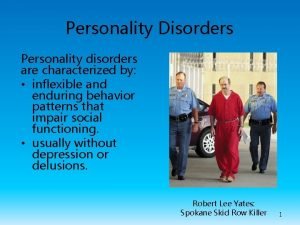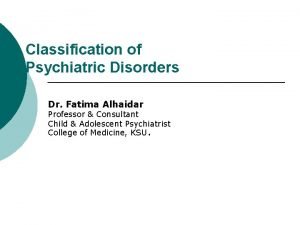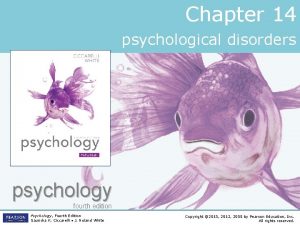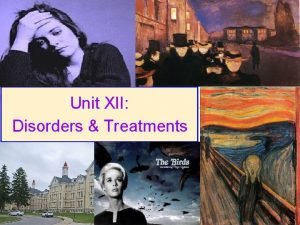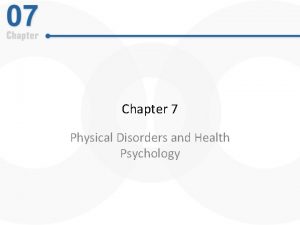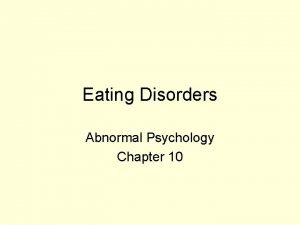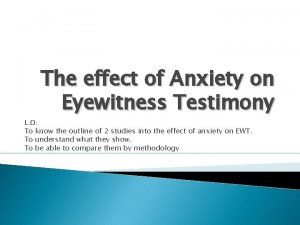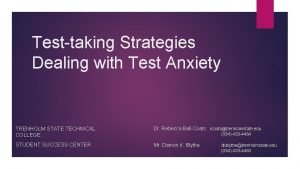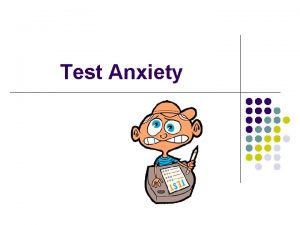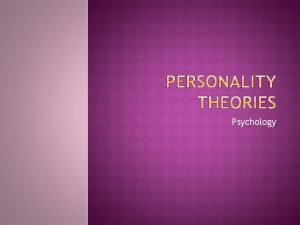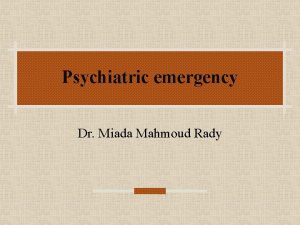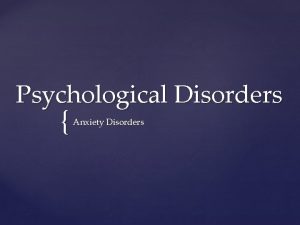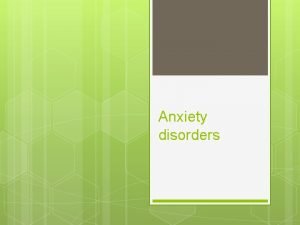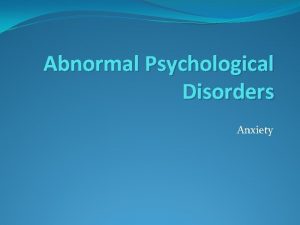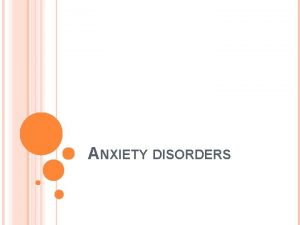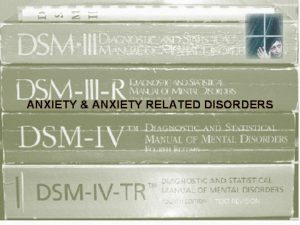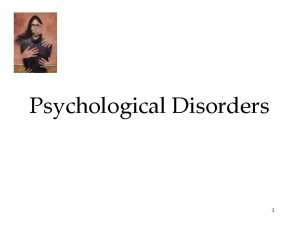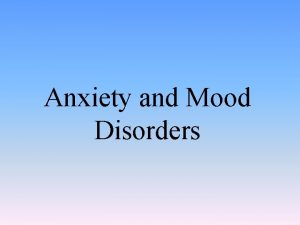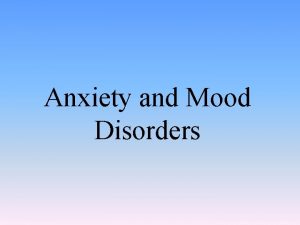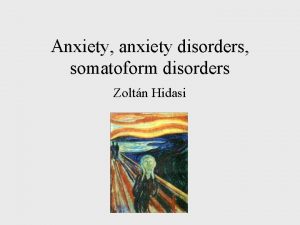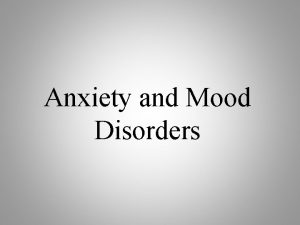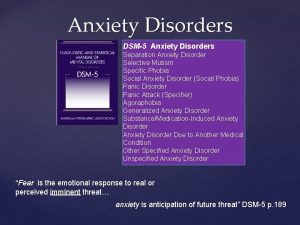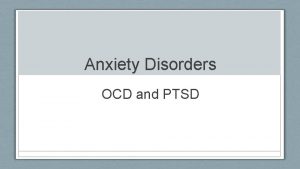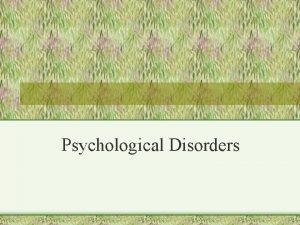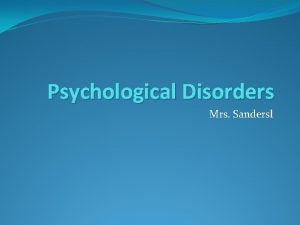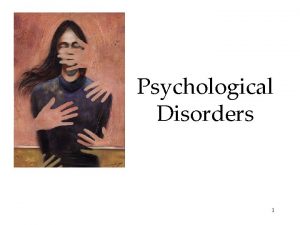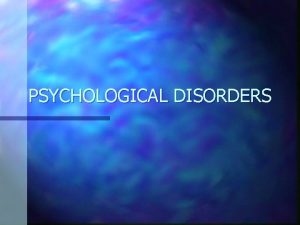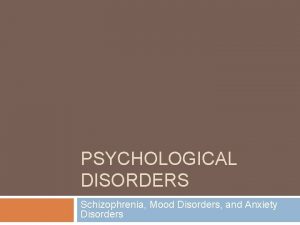VARIOUS DISORDERS INTRODUCTION TO PSYCHOLOGY ANXIETY DISORDERS Psychological



















- Slides: 19

VARIOUS DISORDERS INTRODUCTION TO PSYCHOLOGY

ANXIETY DISORDERS • Psychological disorders characterized by distressing, persistent anxiety or maladaptive behaviors

ANXIETY DISORDERS • Generalized Anxiety Disorder • When a person is unexplainably and continually tense and uneasy • Panic Disorder • When a person experiences sudden episodes of intense dread • Phobias • When a person feels irrationally and intensely afraid of a specific subject or situation • Obsessive Compulsive Disorder • When a person is troubled by repetitive thoughts or actions • Post Traumatic Stress Disorder • When a person has lingering memories, nightmares, and other symptoms for weeks after a severely threatening, uncontrollable event

GENERAL ANXIETY DISORDER • An anxiety disorder in which a person is continually tense, apprehensive, and in a state of autonomic nervous system arousal • People with this condition worry continually, and they are often jittery, agitated and sleep-deprived • Concentration is difficult and switches from worry to worry, and their tension and apprehension may leak out through furrowed brows, twitching eyelids, trembling, perspiration, or fidgeting. • One of the worst characteristics of this disorder is that the person cannot identify, and therefore cannot deal with or identify its cause.

PANIC DISORDER • An anxiety disorder marked by unpredictable minutes-long episodes of intense dread in which a person experiences terror and accompanying chest pain, choking, or other frightening sensations. • 1 in 75 people have this disorder • Smokers have double the risk of this disorder because nicotine is a stimulant.

PHOBIAS • An anxiety disorder marked by a persistent, irrational fear and avoidance of a specific object, activity, or situation • ie: animals, insects, heights, blood, or close spaces.

PHOBIAS

OBSESSIVE COMPULSIVE DISORDER • An anxiety disorder characterized by unwanted repetitive thoughts (obsessions) and/or actions compulsions) • OCD is more common among teens and young adults

OCD

POST-TRAUMATIC STRESS DISORDER • An anxiety disorder characterized by haunting memories, nightmares, social withdraw, jumpy anxiety, and/or insomnia that lingers for four weeks or more after a traumatic experience. • Initially called ”shellshock” or “battle fatigue” for war veterans • However PTSD symptoms have also been reported by survivors of accidents, disasters, and violent assaults

PTSD • What determines if a person develops PTSD after a traumatic event? • The greater one’s emotional distress during the trauma, the higher the risk for PTSD symptoms • A sensitive limbic system – floods the body with stress hormones again and again as images of the traumatic experience erupt into consciousness. • Some think genes may play a role • Those who experience trauma, but do not develop PTSD are said to have a survivor resiliency

DISSOCIATIVE DISORDERS • Disorders of the consciousness, in which a person appears to experience a sudden loss of memory or change in identity, often in response to an overwhelmingly stressful situation. • One’s conscious awareness is said to dissociate (become separated) from painful memories, thoughts, and feelings.

DISSOCIATIVE IDENTITY DISORDER • A rare dissociative disorder in which a person exhibits two or more distinct and alternating personalities (formerly called multiple personality disorder)

PERSONALITY DISORDERS • Personality disorders are disruptive, inflexible, and enduring behavior patterns that impair people’s social functioning. • There are three clusters of thee disorders • Cluster A expresses eccentric behaviors, such as the emotionless disengagement of schizoid personality disorder • Cluster B exhibits dramatic or impulsive behaviors, such as the attention getting histrionic personality disorder and the self-focused and self-inflating narcissistic personality disorder • Cluster C expresses anxiety, such as a fearful sensitivity to rejection that predisposes the withdrawn avoidant personality disorder.

ANTISOCIAL PERSONALITY DISORDER • A personality disorder in which the person exhibits a lack of conscience for wrongdoing, even toward friends and family members. May be aggressive and ruthless or a clever con artist (formerly called a sociopath or a psychopath) • Typically a male whose lack of conscience becomes clear before age 15, as he begins to lie, steal, fight, or display unrestrained sexual behavior. • About half of children become antisocial adults – unable to keep a job, irresponsible as a spouse or parent, and assaultive or otherwise criminal • When antisocial behavior is combined with high intelligence with amorality, the result may be a charming and clever con artist or even worse.

SCHIZOPHRENIA • A group of severe disorders characterized by disorganized and delusional thinking, disturbed perceptions, and inappropriate emotions and actions. • Schizophrenia is the chief example of a psychotic disorder, a disorder marked by irrationality and lost contact with reality • Typically strikes both young men and women heading into adulthood

SYMPTOMS (+/-)

SUBTYPES OF SCHIZOPHRENIA

CAUSES • Brain Abnormalities • Dopamine Over Activity • Abnormal Brain Activity and Anatomy • Genes
 Ap psychology chapter 15
Ap psychology chapter 15 Chapter 15 anxiety and obsessive-compulsive disorders
Chapter 15 anxiety and obsessive-compulsive disorders Anxiety disorders def
Anxiety disorders def Icd x anxiety disorders
Icd x anxiety disorders Multipath model of anxiety disorders
Multipath model of anxiety disorders Chapter 18 psychological disorders review worksheet
Chapter 18 psychological disorders review worksheet Inflexible personality
Inflexible personality Psychiatric disorders
Psychiatric disorders Chapter 18 psychological disorders
Chapter 18 psychological disorders Chapter 14 psychological disorders
Chapter 14 psychological disorders Chapter 14 psychological disorders
Chapter 14 psychological disorders Schizoid personality disorder
Schizoid personality disorder Physical disorders and health psychology
Physical disorders and health psychology Eating disorders abnormal psychology
Eating disorders abnormal psychology Igor areh
Igor areh Relaxation techniques test anxiety
Relaxation techniques test anxiety Anxiety symptoms
Anxiety symptoms I'm a perfect example of someone who has math anxiety
I'm a perfect example of someone who has math anxiety Neurotic behavior
Neurotic behavior Anxiety mnemonic
Anxiety mnemonic
